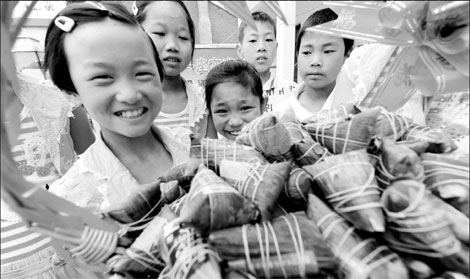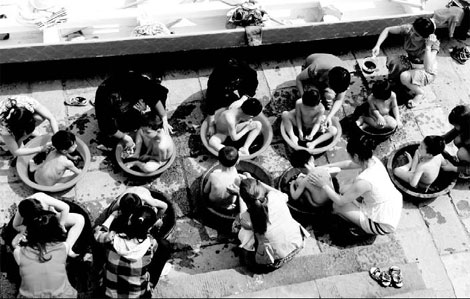Delicacies
The right stuffing
Updated: 2011-06-05 08:07
By Zhang Yue (China Daily)
|
Students from the special education school in Xincai county, Henan province, receive zongzi as festival gifts from the local federation of trade unions. Zhao Xuefeng / For China Daily |
|
Youngsters are bathed in water with mugwort leaf to guard against summer illnesses in Zigui county, Hubei province on May 27, a local tradition in the birthplace of Qu Yuan, whose death is central to the origins of the Dragon Boat Festival. Wang Aiping / China News Service |
Anhui
Diverse zongzi: Shape and taste of traditional festival fare varies by locale
The most popular food for the Dragon Boat Festival are traditional zongzi dumplings made from layers of sticky rice and different fillings wrapped in bamboo or reed leaves.
Though various kinds of zongzi are sold in markets, many people still celebrate the festival by making their own at home as a family tradition.
Three weeks before this year's Dragon Boat Festival, 78-year-old Yuan Ruhua of Hefei in East China's Anhui province started to prepare the traditional food - her yearly routine for the past 50 years.
Reed leaves used in wrapping zongzi appeared in Hefei markets soon after the May Day holiday.
"It's good to keep the leaves in the fridge for some time so they will not be ruined when wrapping," she said.
With many of her neighbors asking her to make zongzi for them, the festival is Yuan's favorite occasion. Some gather at her house to learn the skill.
In fact, her 23-year-old granddaughter Su Yuhan cannot wait until June to enjoy the delicacy. She asked her grandmother to make zongzi to share with her college classmates though the festival was still 10 days away.
"I can recall my grandma's zongzi since childhood. Today, there are finely wrapped zongzi in the supermarket, yet I still like the family food most," she said. "I love to bring
them to my lab and share with my classmates. Grandma uses our favorite fillings, something we can't buy in the supermarket."
According to historical records, zongzi were originally made of millet and chestnuts with no filling. Today popular fillings include sweetened bean, jujube and meat.
Their shape and fillings vary according to locale. In south China, they are usually wrapped in bamboo leaves, with fresh local leaves preferred. People in north China often wrap zongzi in reed leaves.
Generally, people in the north love sweet zongzi. In Beijing, there are three types, with the simplest made only of sticky rice and dipped in sugar when eating. Others have jujube and other preserved fruits or sweet bean paste.
People in the south prefer salty meat as the filling. In Guangdong province, special fillings include egg yolk, salted seafood, green beans and dried mushrooms.
Shanghai zongzi are diverse and exquisite, not only in their fillings but also in shape. Some are wrapped into squares and some into a pentagon.
In Jiaxing, Zhejiang province, the famous old brand Wufangzhai is exquisitely made with well-chosen sticky rice and various fillings such as chicken and salted yolk.
This year, Yuan plans to wrap more than a hundred zongzi with meat, yolk, red bean and sweet jujube fillings. The only shape she is good at making is the tricorn.
"Most of the families love salty food," she said, "So most zongzi I make are meat and yolk."
Yuan bought three kilograms of reed leaves, enough to wrap 10 kilograms of rice. Both rice and meat are marinated in soy sauce for an hour.
With 50 years of experience, Yuan said the procedure is not complicated, but the trickiest part is wrapping, a handiwork that requires patience and hand strength.
Roughly trimmed fresh reed leaves are kept in water so they will not spoil. The first step is placing two reed leaves parallel to each another and folding a third of their length into the shape of a funnel.
"For me the first step is the hardest, but the most important in making an attractive zongzi," said Yuan's daughter. "It takes a lot of practice before you can fold a good funnel shape. When I was learning as a teenager, my mother asked me to practice the first step many times before moving on to the next."
The next step is to fill the funnel with sticky rice and meat. If the funnel is not well folded, rice is likely to leak from the leaves.
"The interesting thing about making zongzi yourself is that you can change the recipe," Yuan said.
In Hefei, there are still many families with older generations that make the delicacy. But for young people living away from home, making the traditional food for Boat Dragon Festival is quite a project.
"My grandchildren are not very interested in learning the skill," Yuan said. "My daughter is the only one that helps out. Young people do not have the patience, but they love buying zongzi from bakery stores and supermarkets."
Wufangzhai, the famous Jiaxing brand, is selling its product online this year. Its store on taobao.com sold almost 12,000 boxes of zongzi in May, and the number is rising.
China Daily
Specials

Birthday a new 'starting point'
China's national English language newspaper aims for a top-notch international all-media group.

Room at the inn
The Chinese hotel industry experiences a building boom, prompting fears of oversupply.

Pearls of wisdom
Chinese pearl farmers dominate the world market but now want to work smarter, not harder

